Not The Bees!
There are almost twenty thousand different named species of bee. These winged insects are close relatives of wasps and ants, and because of their role in pollination – they pollinate around a third of everything humans eat – they’re essential in keeping the Earth’s ecosystems and food chain running smoothly. That’s why the colony collapse disorder that struck US honey bee colonies in 2007 was such a concern. 40% of bee colonies in this country are still dying every year.In short, bees are vital to our survival: humans and bees have coexisted for thousands of years. But it isn’t always the most neighborly relationship. Bee stings are not usually harmful to humans unless you have a severe specific allergy, but they can be very painful.
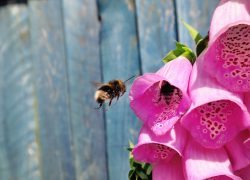
Schedule an Inspection Today
In short, bees are vital to our survival: humans and bees have coexisted for thousands of years. But it isn’t always the most neighborly relationship. Bee stings are not usually harmful to humans unless you have a severe specific allergy, but they can be very painful.
Scientific classification
- Kingdom: Animalia
- Phylum: Arthropoda
- Class: Insecta
- Order: Hymenoptera
- Suborder: Apocrita
- Infraorder: Aculeata
- Superfamily: Apoidea
- Family: There are 7-9 recognized bee families.
Bees at a Glance
There are six main kinds of bees found in Michigan:
- Bumble bees
- Carpenter bees
- Ground bees, such as digger bees and sweat bees
- Honey bees
- Mason and Leafcutter bees
However, these are just a handful of the hundreds of insect varieties found in the states; and many of them – yellow jackets in particular, plus some other species of wasp – can easily be mistaken for bees if you’re not sure what to look for.
Possibly the most well-known differences between bees and wasps is related to their stings: wasps sting aggressively and can do so more than once, while bees will usually sting you only in self-defence, and many species will die after they sting. But if you’ve simply spotted a stripy, buzzing pest in your home and want to know how fast to back away, here are some more useful tips to remember:
- Wasps have nipped-in waists between their thorax and abdomen, whereas most bees’ bodies are of uniform thickness.
- Bees have hairy, almost furry-looking bodies and legs – to help them collect pollen – while Wasps have smooth bodies, and slender legs, and can appear polished and shiny.
- If you come across a nest, it should be easy to tell the difference: Bees’ nests are recognizable by their stacked, hexagonal wax cells. Wasps’ nests are more papery, made out of a pulp the wasps create by chewing fibers.
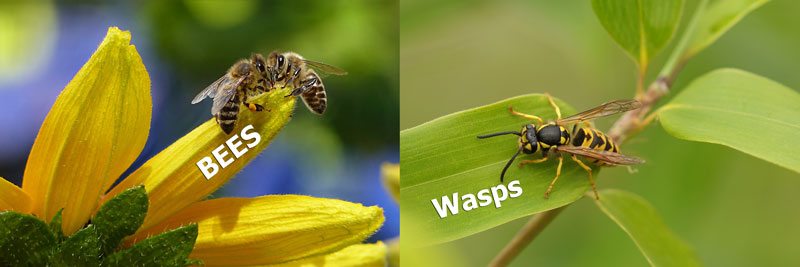
How to identify different kinds of bees
Now you know how to tell a bee from a different kind of pest. But different varieties of bees can pose different kinds of threat to you or your home – so next you need to know how to recognize the different kinds of bee you might come across.

Bumble Bees
Bumble bees have fat, furry little bodies. Female bumble bees can sting, and unlike Honey bees, their stings are not barbed, so they can pull them out and sting again: however, they tend to avoid humans and other animals as much as possible, and will only sting if they or their nest are under attack. Bumble bees are important pollinators, and their species are in decline in North America due to pesticide use and damage to their habitats – so you should do your best to avoid killing them.
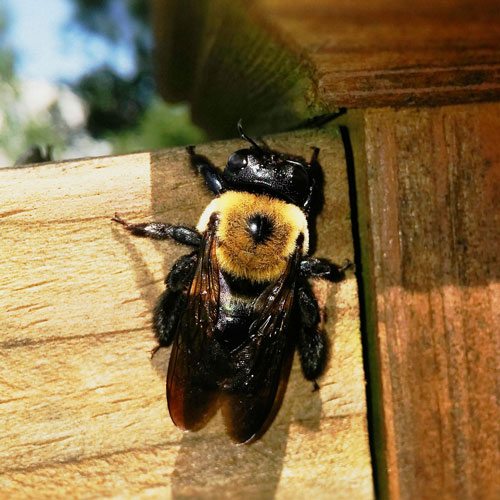
Carpenter Bees
Carpenter bees are often mistaken for bumble bees, but if you get up close, you may be able to tell the difference: carpenter bees have shiny abdomens, while bumblebees are furry all over. They are unlikely to sting you unless provoked or caught in your hand. However, since they build their nests in wood – hence their name – they can cause structural damage to your property over time. But they are also important pollinators so should only be killed as a last resort, when an infestation is getting out of hand.
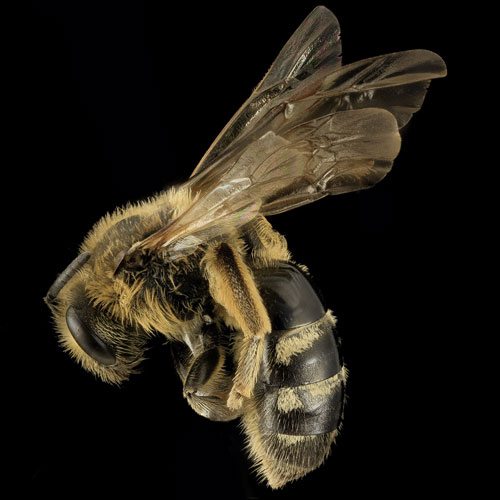
Ground Bees
Ground bees include a great number of varieties. Digger bees vary in size but can be recognized by their furry legs. Sweat bees can be small to medium-sized and brown, metallic green or bronze in color. What they share is a tendency to live in the soil, in solitary burrows – each female ground bee has her own burrow, unlike bumble bees who live in colonies. Ground bees are beneficial pollinators and are not aggressive: you can safely mow the lawn above where they live. Sweat bees have an alarming tendency to land on humans to drink perspiration – hence the name – but are very unlikely to sting unless you slap them.

Honey Bees
Honey bees are also easy to mistake for bumble bees, but you can usually identify a honey bee by remembering that honey bees have more slender bodies, with more defined stripes than bumble bees while being noticeably more furry than wasps. Honey bees will not usually sting unless they or their hive are threatened, and the female worker honey bees are well known for having barbed stings, which get stuck in the skin of humans or other animals and cause the bee to die after stinging. Be warned, particularly around nests: queen honey bees can sting more than once, and if you kill a honey bee within 15 feet of a nest the scent will reach the rest of the colony – who will retaliate. Honey bees are, as their name indicates, incredibly important pollinators, so it’s best to avoid harming them.

Mason Bees/Leafcutter Bees
Mason bees and Leafcutter bees megachilidae family. They are extremely vigorous when collecting pollen, which makes them excellent pollinators – so much so that some species of Leafcutter bee are deliberately imported into the US. Megachilidae bees come in a variety of shapes, sizes, and colors, but you may be able to recognize them by their nests, which they build in pre-existing structures (such as the holes in wood left by carpenter bees; or even inside snail shells). Mason bees line the inside with clay and soil, and leafcutter bees line theirs with leaf fragments. Like most bees, only the females have stingers; they will only sting if trapped or if you squeeze them; and the sting is, in any case, much milder than that of other bees.
What to look for around your home
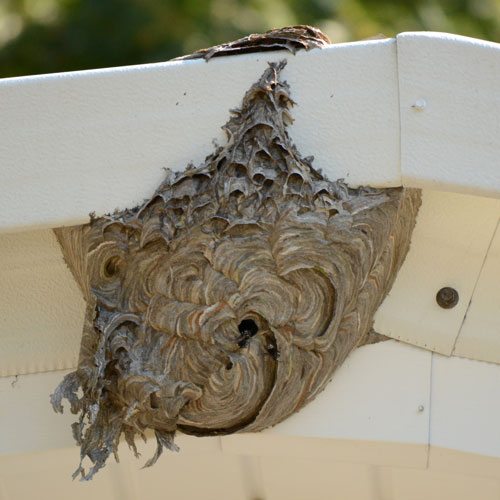
Bees nesting nearby and visiting your garden – or even one or two bees finding their way into your home – is most likely nothing to worry about (unless you or a family member have severe allergies: see the next section for more on this). But a nest that is too large or too close to your home can make it impossible for you and the local bee population to coexist happily and safely, as well as causing potential damage to your property. If it becomes difficult to walk around your yard without walking into bees – or over them – it could be a swarm. Bee swarms are temporary and nothing to worry about – it’s just part of a colony setting off to create a new one. You can call a pest control professional to move the swarm if it’s causing significant problems.
However, if you are still noticing an unusual number of bees one or two days later, there could be a nest uncomfortably close to your home. Once you’ve checked all the obvious places in your yard – such as tree branches – then start looking in the eaves of your house, in the attic, and in the chimney. If you hear buzzing but can’t quite tell where it’s coming from, there may be bees inside the wall – in which case you’ll need to call a professional.
If you have carpenter bees, they will leave distinctive traces: perfectly round holes in any untreated wood in or around your property, often with a little pile of fine sawdust beneath. If you put your ear to a wooden structure, you may even be able to hear the faint rustling sound made by the bees chewing the wood inside.
How to Treat Bee Stings
When treating bee stings, it’s important to know whether the person who has been stung is allergic.A normal reaction to a bee sting is pain and a reddened, swollen area around the sting site. Some people may also experience a significant local reaction – where, for example, the whole stung limb becomes swollen – but this is not the same as an allergic reaction, and is usually not serious.
A normal reaction to a bee sting is pain and a reddened, swollen area around the sting site. Some people may also experience a significant local reaction – where, for example, the whole stung limb becomes swollen – but this is not the same as an allergic reaction, and is usually not serious.
A mild allergic reaction, in which the sting site becomes warm and/or itchy, is usually not serious either – you can treat these symptoms with an over-the-counter antihistamine (not for pregnant women or children under 2).
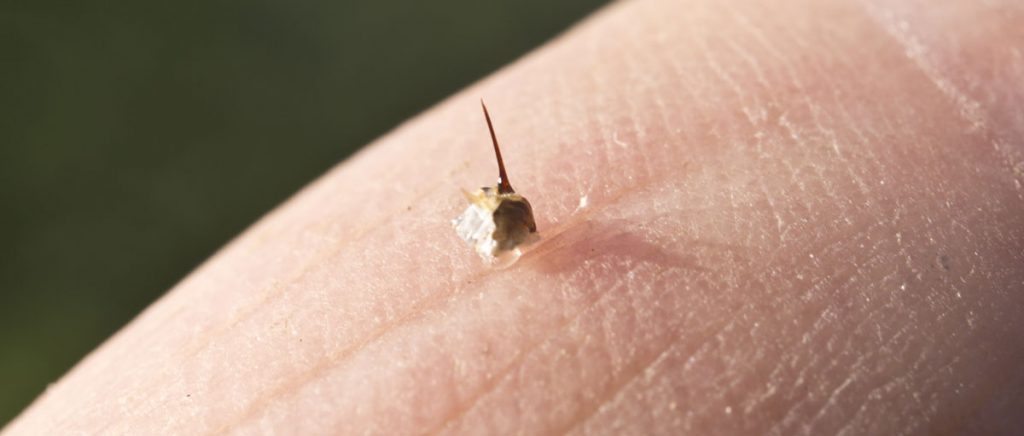
However, an anaphylactic reaction is extremely serious and requires emergency medical treatment – preferably following the use of an epi-pen if the allergic person has one. Symptoms of an anaphylactic reaction can include:
- Anxiety and restlessness
- Breathing difficulties, wheezing and/or trouble swallowing
- Dizziness
- Marked changes in blood pressure – either a sharp drop or a rapid pulse
- Swelling of the mouth, face or throat
For normal reactions, treat as follows:
- If stung on the hand or finger, remove any rings to avoid them getting stuck if and when swelling occurs.
- Remove the stinger with fingernails or tweezers.
- Wash the affected area with soap and water, then apply an antiseptic.
- Soothe the area with an ointment such as calamine, then apply a sterile bandage.
- Treat any swelling with an ice pack.
- Take painkillers such as ibuprofen if required.
Traditional remedies such as baking soda have not been proven to be effective.
There are bees on my property! How do I deal with them?
If at all possible, leave the bees alone. They’re endangered, vital links in the food chain, and they won’t hurt you unless provoked.
However, if bees – particularly carpenter bees – are nesting inside your property, or if you live with or very near someone who is severely allergic, then it’s time to take action. You will need a pest control professional to get rid of bees safely and responsibly, but the tips below may help you minimize the impact of a local bee population and/or prevent them from returning.
DIY Pest Control
It’s worth repeating that bees have an overwhelmingly positive impact on our environment and that you should encourage them if you possibly can. But if you have a compelling reason to keep bees away – such as severe allergy – then you could try the following:
- Design bees out of your garden by avoiding the flowers they prefer: the obvious flowers are any with ‘bee’ or ‘honey’ in their name, like bee balm or honeysuckle; but any particularly fragrant flower is attractive to bees.
- If you notice bees are attracted to any particular trees in your garden, trim them to reduce the number of flowers they produce.
- If a small number of bees continue to visit your garden, you could try making a homemade bee trap. Cut the top few inches off a soda bottle, and cover the bottom of the bottle in a thin layer of bee bait, like sugar syrup or fruit juice. Turn the top part of the bottle upside down, placing it inside the bottom piece of the bottle like a funnel, and then staple it into place. Hang this at the entrance to your yard: bees will be attracted inside by the bait but won’t be able to find their way out.
If you have bees on your property and want them removed from the premises, contact the experts at Pronto Pest Management. We specialize in bee removal as well as the identification and extermination of bed bugs.
